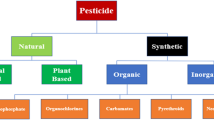Abstract
Biodegradation is a natural process, where the degradation of a xenobiotic chemical or pesticide by an organism is primarily a strategy for their own survival. Most of these microbes work in natural environment but some modifications can be brought about to encourage the organisms to degrade the pesticide at a faster rate in a limited time frame. This capability of microbe is some times utilized as technology for removal of contaminant from actual site. Knowledge of physiology, biochemistry and genetics of the desired microbe may further enhance the microbial process to achieve bioremediation with precision and with limited or no scope for uncertainty and variability in microbe functioning. Gene encoding for enzyme has been identified for several pesticides, which will provide a new inputs in understanding the microbial capability to degrade a pesticide and develop a super strain to achieve the desired result of bioremediation in a short time.
Similar content being viewed by others
References
Stotzky G, Goos RD and Timonin MI (1962) Microbial changes occurring in soil as result of storage. Plant Soil 16: 1–19
Burn RG (1988) Experimental models in study of soil microbiology. In: Hand Book of Laboratory model systems for Microbial Ecosystems (J W T Wimpeny ed). CRC Press Boca Raton, Florida pp 51–98
Hong Q, Zhang Z, Hong Y and Li S (2007) A microcosum study on bioremediation of fenitrothion-contaminated soil using Burkholderia sp. FDS-1. In Bioremediation Biodegradation 59:55–61
Kumar M and Philip L (2006) Bioremediation of endosulfan contaminated soil and water-optimization of operating conditions in laboratory scale reactors. J Hazardous Materials 136:354–364
Henry L and Kishimba MA (2006) Pesticide residues in Nile tilapia (Oreochromis niloticus) and Nile perch (Lates niloticus) from Southern Lake Victoria, Tanzania. Environ Pollut 140:348–354
Kumar M and Philip L (2006) Enrichment and isolation of a mixed bacterial culture for complete mineralization of endosulfan. J Environ Sci Health B 41:81–96
Kumar M and Philip L (2006) Endosulfan mineralization by bacterial isolates and possible degradation pathway identification. Bioremediation J 10:179–190
Kumar K, Devi SS, Krishnamurthi K, Kanade GS and Chakrabarti T (2007) Enrichment and isolation of endosulfan degrading and detoxifying bacteria. Chemosphere 68:497–488
Gupta KG, Sud RK, Aggarwal PK and Aggarwal JC (1975) Effect of baygon (2-isopropoxyphenyl N-methylcarbamateon some biological process and degradation by a Pseudomonas sps. Plant Soil 42:317–325
Karns JS, Mulbry WW, Nelson JO and Kearney PC (1986) Metabolism of Carbofuran by pure bacterial culture. Pest Biochem Physiol 25:211–217
Larkin MJ and Day MJ (1986) Metabolism of carbaryl by three bacterial isolates, Pseudomonas sps. (NCIB 12042 and 12043), Rhodococcus sp (NCIB 12038) from garden soil. J Appl Bacteriol 60:233–242
Chaudhry GR and Ali AN (1988) Bacterial metabolism of carbofuran. Appl Environ Microbiol 54:1414–1419
Chapalmadugu S and Chaudhry GR (1991) Hydrolysis of Carbaryl by Pseudomonas sps. And construction of microbial consoritum that completely metabolised carbaryl. Appl Environm Microbiol 57:744–750
Mulbry WW and Eaton RE (1991) Purification and characterization of the N-methylcarbamate hydrolase from Pseudomonas strain OK. Appl Environ Microbiol 57:3679–3682
Head IM, Cain RB and Suett DL (1992) Characterization of carbofuran degrading bacterium and investigation of the role of plasmids in catabolism of the insecticide carbofuran. Arch Microbiol 158:302–308
Topp E, Hansen RS, Ringleberg DB, White DC and Wheatcroft R (1993) Isolation and characterization of an n-methylcarbamate insecticide degrading methylotrophic bacterium. Appl Environ Microbiol 59:3339–3349
Kearney PC and Roberts T (1998) In: Pesticide remediation in soil and water (Kearney PC and Roberts T eds) Wiley series in agrochemical and plant protection. John Wiley and Sons, New York
Kumari R, Subudhi S, Suar M, Dhingra G, Raina V, Dogra C, Lal S, Meer JR, Holliger C and Lal R (2002) Cloning and Characterization of lin Genes Responsible for the Degradation of Hexachlorocyclohexane Isomers by Sphingomonas paucimobilis Strain B90. Appl Environ Microbiol 68: 6021–6028
Sutherland TD, Home I, Harcourt RL, Russel RJ and Oakeshott JG (2002) Isolation and characterization of a Mycobacterium strain that metabolizes the insecticide endosulfan. J Appl Microbiol 93:380–389
Hussain S, Arshad M, Saleem M and Khalid A (2007) Biodegradation of α and β endosulfan by soil bacteria. Biodegradation 18:731–740
Barraga n-Huerta BE, Costa-Pe’rez C, Peralta-Cruz j and Barrera-Corte J (2007) Biodegration of organochlorine pesticides by bacteria grown in microniches of the porus structure of green bean coffee. In Biodeterioration Biodegradation 59:239–244
Subhas and Singh DK (2003) Utilization of monocrotophos as phosphorus source by Pseudomonas aeruginosa F10B and Clavibacter michiganense subsp. insidiosum SBL 11 Canad J of Microbiol 49:101–109
Das S and Singh DK (2006) Purification and characterization of phosphotriesterases from Pseudomonas aeruginosa F10B and Clavibacter michiganense subsp. insidiosum SBL11. Canad J of Microbiol 52:157–168
Weir KM, Sutherland TD, Horne I, Russell RJ and Oakeshott JG (2006) A Single Monooxygenase, Ese, Is Involved in the Metabolism of the Organochlorides Endosulfan and Endosulfate in an Arthrobacter sp. Appl Environ Microbiol 72: 3524–3530
Lal R, Dogra C, Malhotra S, Sharma P and Pal R (2006) Diversity, Distribution and Divergence of lin genes in hexachlorocyclohexane degrading sphingomonads. TRENDS in Biotechnology 24:121–129
Author information
Authors and Affiliations
Corresponding author
Rights and permissions
About this article
Cite this article
Singh, D.K. Biodegradation and bioremediation of pesticide in soil: concept, method and recent developments. Indian J Microbiol 48, 35–40 (2008). https://doi.org/10.1007/s12088-008-0004-7
Received:
Revised:
Accepted:
Published:
Issue Date:
DOI: https://doi.org/10.1007/s12088-008-0004-7




